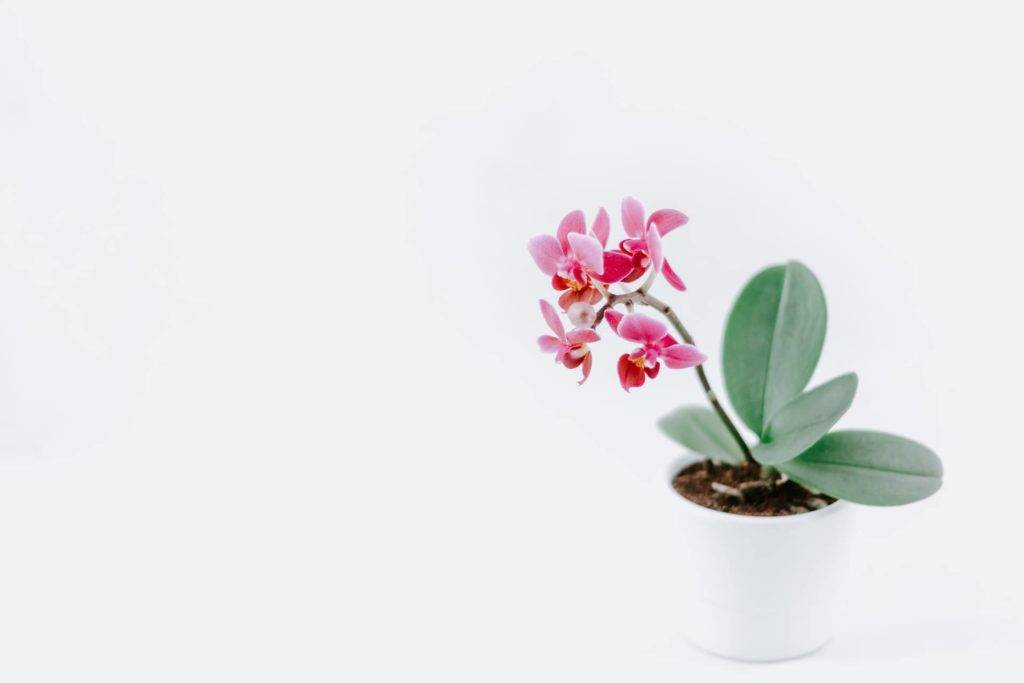The bark is one of the best growing media for orchids. So you are wondering: how to water orchids in bark! In this article, we will answer this question. And we will discuss the water needs of orchids. And how bark can satisfy those needs. Also, we gonna distinguish the types of orchids that may need more watering from the ones that don’t.
But before diving deep into the details I will put the answer for our main question as simple as this: how to water orchids in the bark? The best way to water orchids that grow in the bark is by slowly pouring the water in the bark. And allow the water to drain completely. In some cases, you may need to soak the bark for 5 minutes if your climate is dry. But if you live in a humid environment the pouring method will be enough. Keep reading to know the water needs of orchids.

Orchid’s water needs and how bark can satisfy those needs
Orchids have aerial roots. That means it absorbs moisture and nutrients from the air through its roots. Therefore it needs a growing medium that allows air circulation in the root zone. Also, its roots need a humid environment.
Bark as a growing medium for orchids allows enough air circulation and humidity in the root zone. Although bark has less water retention ability went compared with sphagnum moss. And it drains really well.
Different types of orchids have different water needs
Some orchids have the ability of water storage. Orchids like most Bullophyllum, some Cattleyas, and most Coelogyne. Such orchids types need a little drought time between waterings.
In order to use their stored water. Such orchids are susceptible to root rot in case of overwatering. On the other hand, there is another type of orchis that do not have water storage abilities.
Orchids like Vandas, Phalaenopsis, and Paphiopedilums. Those types require relatively more frequent watering when compared with the ones that have water storage ability.
Also, They are more susceptible to leaves wilting in case of under-watering.
The right way to water orchids that growing in bark
There is no universal watering schedule that will work for everyone. Because there different factors that govern the right watering schedule.
Factors like the temperature, humidity, and the type of orchid. The hotter the weather the more watering your orchid will need. And the more humid the air around the orchid the less water it will need.
Also, as I mentioned earlier, an orchid that has water storage ability will need less watering when compared with the one that doesn’t have water storage ability. So, research your specific orchid type to know if it has water storage ability or not.
That being said, The standard way to water your orchids that growing in the bark is simply by pouring water slowly in the bark from above.
Make sure to cover all the bark particles. Water when the bark approaching dryness. And make sure you are using a pot that has plenty of drainage holes in order to drain the excess water.
You know that your orchid needs watering if its roots turned to silver color. You can also tell by the color of the bark chips if it turns to a brown color it means it dry.
Bark will dry from the top to the bottom. Therefore you may notice that the color of the upper part is brighter than the lower part, assuming that you are using a clear plastic pot.
When you became experienced with the watering you can tell if your plant needs watering from the weight of the pot, when the bark is lightweight it means it is dry.
Some times you may need to soak the orchid bark
The general rule is to water your orchid that growing in the bark is to pour water in the bark slowly and let the water drain completely. But some times you may need to soak the bark, the following are the situations when soaking can lead to better results
When the bark is fresh and new
When the bark is new it tends to absorb less water. As it ages it opens up and became more absorbent. Therefore if just planted your orchid in new bark give the bark a good soak in order to retain enough moisture.
When the weather is dry
Orchids love humidity. If you live in a place that has a dry climate soaking the orchid bark will be good options. In order to absorb and retain enough moisture.
When your orchid has no water storage abilities
As I mentioned earlier some orchids have a part that stores water and nutrients such types don’t appreciate a lot of moisture. Therefore if your orchid is one of those types, from the type viewpoint don’t soak the bark.
Still, you can consider the other factors like humidity level and bark age to decide if you need to soak the bark or not. But from the orchid standpoint, they do not need soaking.
On the other hand, orchids types that don’t have a part to store water like Vandas, Phalaenopsis, and Paphiopedilums will benefit from bark’s soaking with taking into consideration the other factors.
How to soak orchid’s bark
If you did your calculations and found that your orchid will appreciate soaking, Put your orchid pot under a continuous stream of water for a while until all bark chips became saturated with water.
Or, if your planter allows holding water without draining it pour plenty of water in the bark. And let the water sit in the bark for 5 minutes. Then free the pot in order to drain the excess water.
Which water type you should use to water orchids in bark
Most tap waters have a high pH value to the extent that will build salts in the bark through time. Such a thing will make the roots unable to absorb nutrients from the bark.
Therefore use purified or rainwater to water your orchid. In case only you only have access to tap water before using it, let the tap water set in an open container overnight in order for some treated chemicals to dissipate in the air
In conclusion
In this article, I hope I answered one of my readers’ most asked questions: how to water orchids in the bark? the general and effective rule for watering orchids that grow in the bark is by pouring water slowly in all bark chips and allowing for immediate drainage.
But their factors that make soaking bark in the water a good option. Such factors are the weather ( humidity level), orchid type, and whether the bark is new or not.
